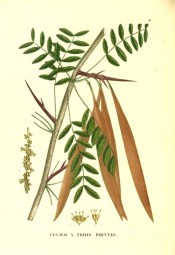Gleditsia triacanthos L.
Spreading, deciduous tree with a spiny trunk and shoots, the spines branched and up to 15cm long. It has pinnate leaves, to 25cm long, composed of up to 24 leaflets, and pendant, sickle-shaped seed pods, to 45cm long, in summer and autumn. To 30m. [RHSE, Hortus, Hilliers’].
Horticultural & Botanical History
‘Here is a tree which so much resembles the common Locust [Robinia species] in its leaves, fruit, and wood that there should be no wonder that it is called a Locust, yet, botanically speaking, it is not a Locust. The prefix “honey” to the common name has, no doubt, been given because of the sweetness of its seed-pods. However incorrect its common name may be, it has come to stay, although it has several others by which it is known. The tree may be readily recognized by the prominent thorns or spines which almost invariably appear on the stem and limbs. These are, probably, abortive developments of adventitious buds, sometimes single, but more generally three-forked, hence the botanical designation triacanthos.
As indicated, its wood closely resembles that of the common Locust, and all efforts to ascertain whether there is any distinction made in the lumber trade have failed. There should be no discrimination made against the Honey Locust, for its wood is quite equal in value to the common Locust for all purposes, and in fact superior to it for some.
Like the common Locust, its natural range was somewhat restricted, but it has been spread, mainly for ornamental purposes, over a much larger area than it originally occupied. Its original home extended from central New York south to Georgia and from the Alleghany Mountains to eastern Kansas and Nebraska, but it may be found as an ornamental tree, or grown for hedges, in almost every state east of central Kansas.’ [S. B. Elliot - The important Timber Trees of the United States p.323/1912].
Introduced to Europe in 1700. [PD]. Saint-Hilaire Arb. pl.31/1824.
History at Camden Park
Listed in all published catalogues [T.521/1843]. Naturalised in the Camden area, sometimes a serious weed. A notebook in the Macarthur Papers held in the Mitchell Library has extensive notes on trees planted in Geneva and Montreux. Although attributed to William Macarthur the notes are probably in John Macarthur Snrs. hand, made during the Europe tour. He wrote on live fences: ‘Honeylocust or Triacanthus, an American Plant, supposed to be good for forming a live fence. Thorn is said to make the best fences when the soil is good. Crab the next best but Beech, Hornbeam and Berberry on thin dry soils. Elder, Birch, Poplar and Alder make good fences on rich soils. For instructions to prepare the soil see Farmers Magazine page 83, vol. 6.’ Elsewhere William Macarthur comments ‘[Honeylocust] makes good handles and although [the word is unclear] difficult to obtain a proper size produces useful timber for indoor purposes.’ Farmers Magazine page 39, vol. 5. This entry is possibly from 3rd Feb, 1824. [MP A2951].
Notes
Published Dec 21, 2009 - 05:05 PM | Last updated Jul 21, 2010 - 12:09 PM
| Family | Fabaceae |
|---|---|
| Category | |
| Region of origin | North America |
| Synonyms | |
| Common Name | Honey locust, Three thorned acacia, American thorn |
| Name in the Camden Park Record |
Gleditschia triacanthus - American Triacanthus |
| Confidence level | high |
